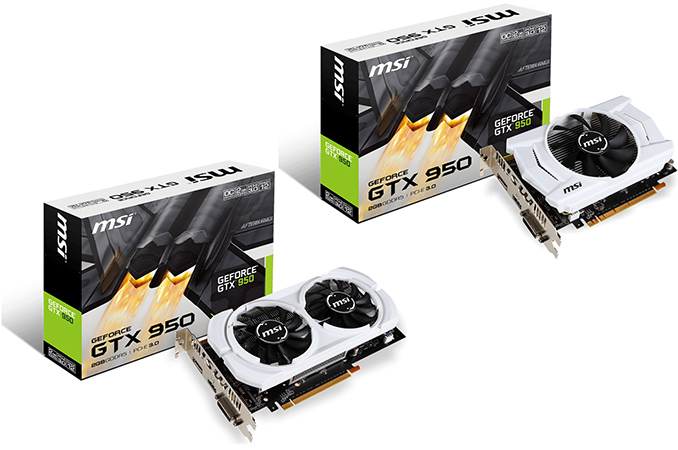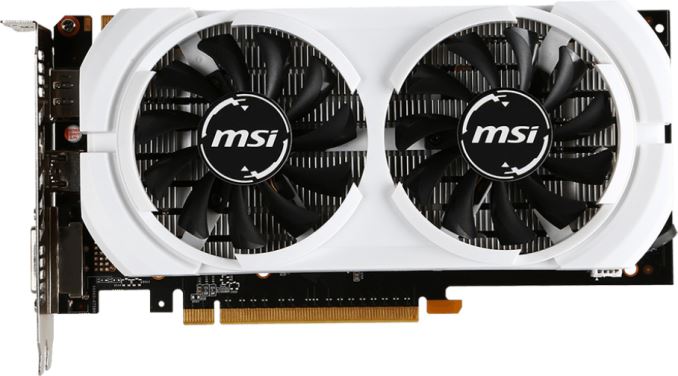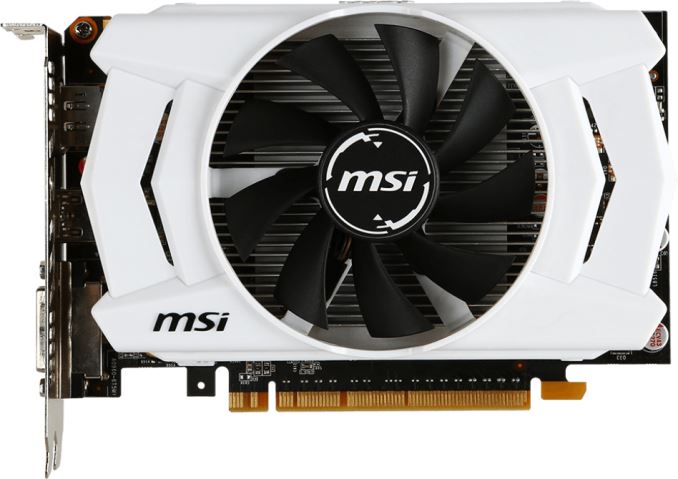MSI Introduces two new GTX 950 2GB GPUs with 75W TDP: the OCV2 and OCV3
by Anton Shilov on March 16, 2016 12:00 PM EST
A standard GTX 950 reference design comes in at a 90W TDP, which means it requires a 6-pin PCIe power connector as the standard PCIe slot is typically rated to only provide 75W. However, we have seen a couple of AIB partners introducing new 75W versions of the GTX 950 to come in under the limit, and as a result remove the 6-pin PCIe connector needed. One of those is MSI, who has introduced two new video cards that can be powered solely by the PCI Express connection. The low-power GeForce GTX 950 graphics boards from MSI follow similar graphics adapters from ASUS and indicate that there are NVIDIA’s GM206-251 GPUs. At this point we might conclude that the '251' nomenclature refers to the specific silicon design which might afford lower power operation.
The two new cards from MSI are the GeForce GTX 950 2GD5T OCV3 and the MSI GeForce GTX 950 2GD5T OCV2 and are based on the GeForce GTX 950 (GM206) in its default configuration: 768 stream processors, 48 texture units, 32 ROPs as well as a 128-bit GDDR5 memory interface. The GPUs of both cards are clocked at 1076 MHz, but can increase their frequencies to 1253 MHz in boost mode. Both graphics adapters are equipped with 2 GB of GDDR5 memory clocked at 6.6 Gbps, a dual-slot cooling system with an aluminum heatsink, one DVI connector, one HDMI 2.0 port and one DisplayPort output. As mentioned above, neither of the boards require additional PCIe power connectors and their TDP does not exceed 75 W.
The two cards differ in their cooling and length. The first one is the GTX 950 2GD5T OCV3 uses a dual fan design and features a longer PCB which is designed to focus on a typical desktop PC. The shorter GTX 950 2GD5T OCV2 uses a single fan and seems to be designed for mini-ITX systems. Thanks to the fact that the GM206 GPU features hardware-accelerated decoding and encoding of H.265 (HEVC) video and fully supports HDCP 2.2 content protection over HDMI 2.0, the OCV2 card could be a fine choice for small form-factor home-theater PCs.
That being said we have noticed that on the stock photographs that the smaller model eliminates some of the PCI Express pins for an unknown reason, so the exact feature-set is to be confirmed. We have put questions to MSI on this and will update when we have a response.
Graphics cards based on the GeForce GTX 950 GPUs with lowered power consumption can be used not only to build SFF HTPCs, but also to upgrade cheap desktop systems, which sometimes do not have a spare PCIe power connector inside. Previously NVIDIA’s partners only offered GeForce GTX 750 Ti without auxiliary power connectors, but this adapter is already two years old, and its performance may not enough for modern titles.
Now there are (at least) two graphics cards suppliers who offer GeForce GTX 950 adapters with lowered power consumption, it is likely that other companies will follow them as well. It is unclear whether NVIDIA officially sells GM206 GPUs with low TDP to address the market of entry-level desktops, or companies like ASUS or MSI simply hand-pick GPUs that do not need more than 75 W of power to function properly. In any case, it is evident that such GPUs exist and are in demand enough that the AIB partners want to produce them.
| NVIDIA Video Card Specification Comparison | |||||||
| MSI GTX 950 OCV2/3 | ASUS GTX950-2G | Ref GTX 950 |
Ref GTX 960 |
Ref GTX 750 Ti |
|||
| CUDA Cores | 768 | 1024 | 640 | ||||
| Texture Units | 48 | 64 | 40 | ||||
| ROPs | 32 | 16 | |||||
| Core Clock | 1076 MHz | 1026 MHz | 1024 MHz | 1126 MHz | 1020 MHz | ||
| Boost Clock | 1253 MHz | 1190 MHz | 1188 MHz | 1178 MHz | 1085 MHz | ||
| Memory Clock | 6.6 Gbps GDDR5 |
7 Gbps GDDR5 |
5.4 Gbps GDDR5 |
||||
| Memory Bus Width | 128-bit | ||||||
| VRAM | 2 GB | 2/4 GB | 2 GB | ||||
| TDP | 75 W | 90 W | 120 W | 60 W | |||
| Architecture | Maxwell 2 | Maxwell 1 | |||||
| GPU | GM206 | GM107 | |||||
| Transistor Count | 2.94 B | 1.87B | |||||
| Manufacturing Process | TSMC 28nm | TSMC 28nm | |||||
| Launch Date | 03/16/16 | 03/16/16 | 08/20/15 | 01/22/15 | 02/18/14 | ||
| Launch Price | unknown | unknown | $159 | $199 | $149 | ||
Exact prices and release dates of MSI’s GeForce GTX 950 2GD5T OCV3 and GeForce GTX 950 2GD5T OCV2 graphics cards are unknown. Keeping in mind that the boards are not exclusive products available only from MSI, their prices will hardly be very high and will be near the GTX 950’s MSRP of $159.
Source: MSI


















12 Comments
View All Comments
Valantar - Thursday, March 17, 2016 - link
If this list of PCIe pinouts is correct (http://pinouts.ru/Slots/pci_express_pinout.shtml), then the missing pins are:B5 SMCLK SMBus clock
B6 SMDAT SMBus data
B9 JTAG1 +TRST#
B10 3.3Vaux 3.3v volt power
B11 WAKE# Link Reactivation
Mechanical key
B12 RSVD Reserved
B17 PRSNT#2 Hotplug detect
B30 RSVD Reserved
B31 PRSNT#2 Hot plug detect
B48 PRSNT#2 Hot plug detect
And all the way at the end:
B82 RSVD#2 Hot Plug Detect
I have no idea what the first bunch do, but otherwise they seem to have removed hotplug capability and unused pins? If my guess from skimming the Wikipedia article on SMbus, that would be used for on/off signaling of the card, which I would guess can also be related to hotplug use. And do modern GPUs use 3.3V at all?
wolfie.jacobs - Friday, March 18, 2016 - link
My power connected 950gtx also has few missing pin. Not sure if it affect any of the performance, here is the benchmark I just ran, can any of 950gtx users with proper pin also share your performance score to settle my concern?https://www.dropbox.com/s/vi0i7a67t677rm5/950.test...
https://www.dropbox.com/s/4edjrc0gomp6wbu/rsz_img_...